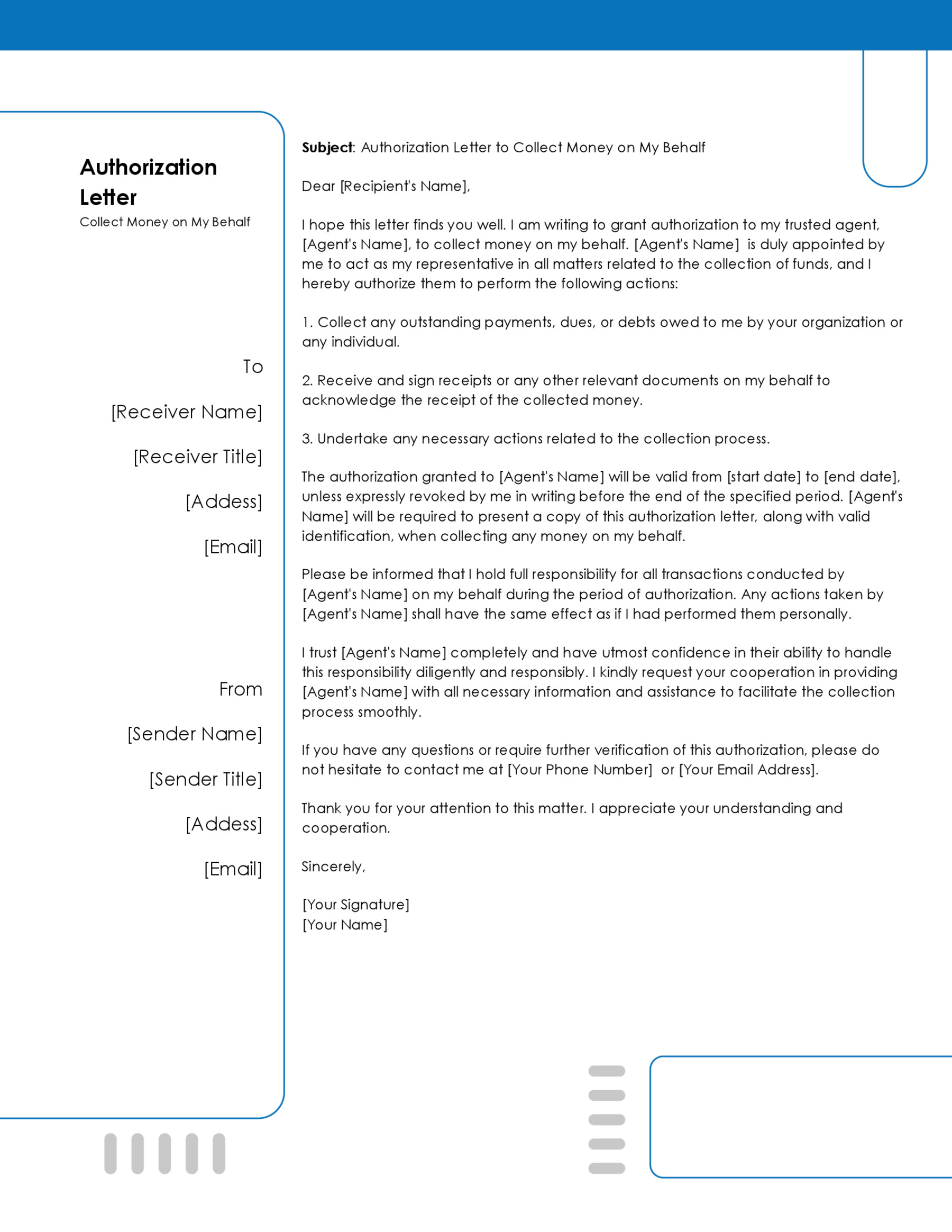A rental confirmation letter is one of the simplest tasks a landlord will need to carry out for their tenants. Although it is sometimes referred to as a rental affidavit or proof of residency, this letter comes from a landlord to confirm tenancy.
This is often helpful for younger tenants or those who will find a low credit history to demonstrate credibility and live somewhere. This letter can differ from landlord reference letters, so this article will elucidate all the information included in these letters and how a landlord can write one.
A proof of residence letter is a straightforward document from a landlord that confirms the tenancy; that is, a tenant lives in their rental unit.
It is a brief letter that confirms tenancy with a third party. If they live in your rental unit, there is no problem confirming this, but being dishonest or lying in these types of documents can cause legal issues.
Additional Templates
Here are free, customizable templates for you that you can edit as per your needs:
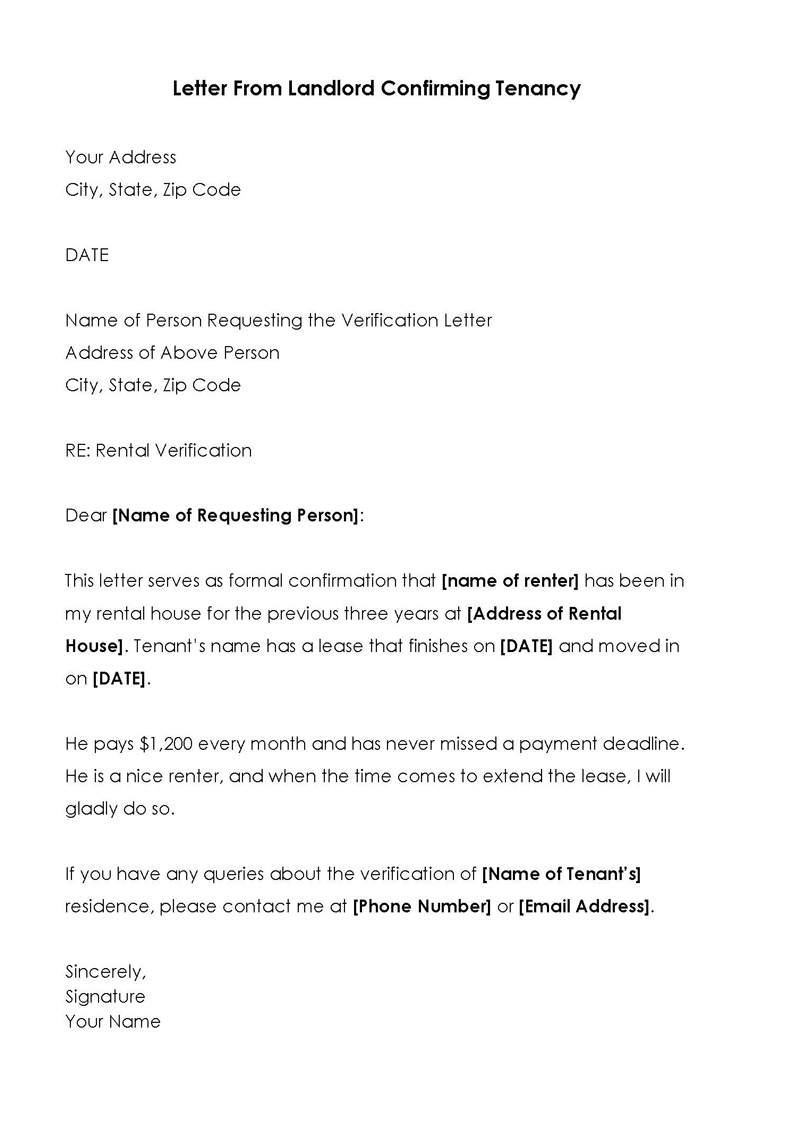
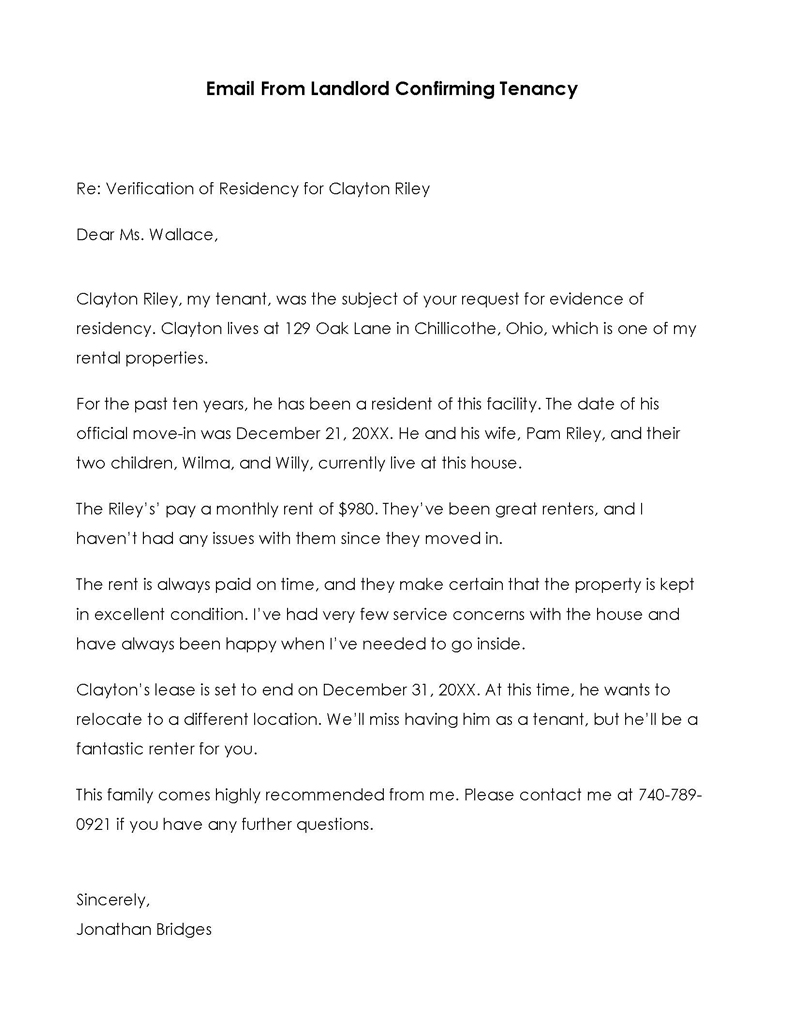
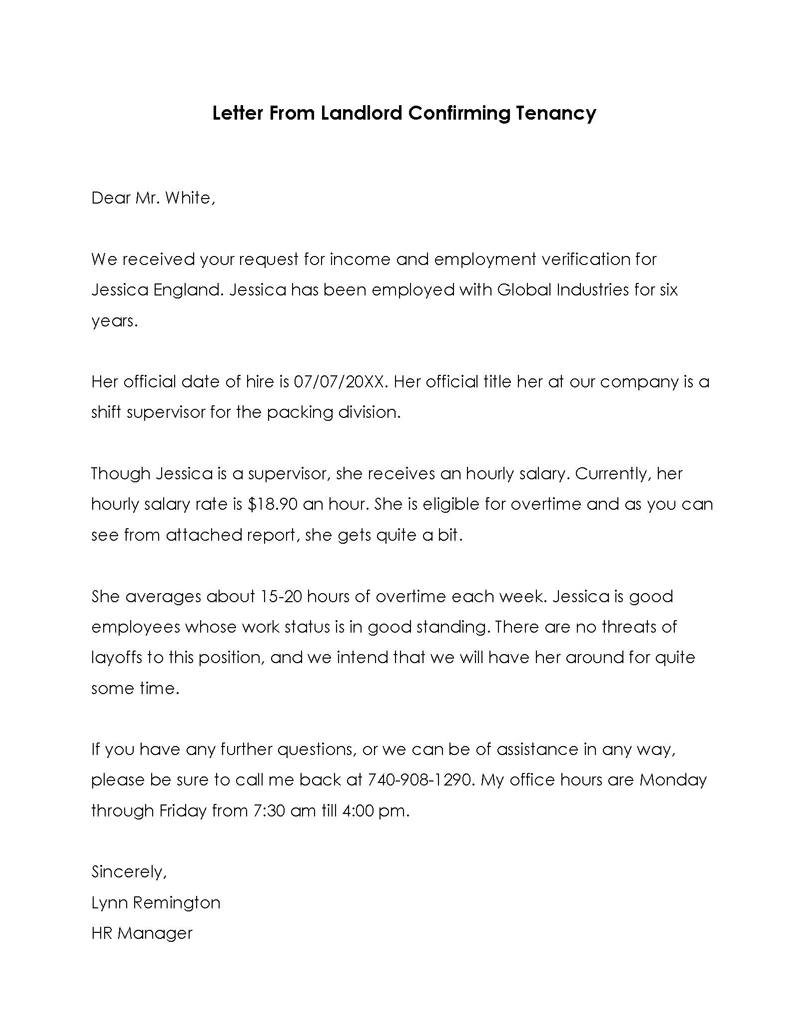
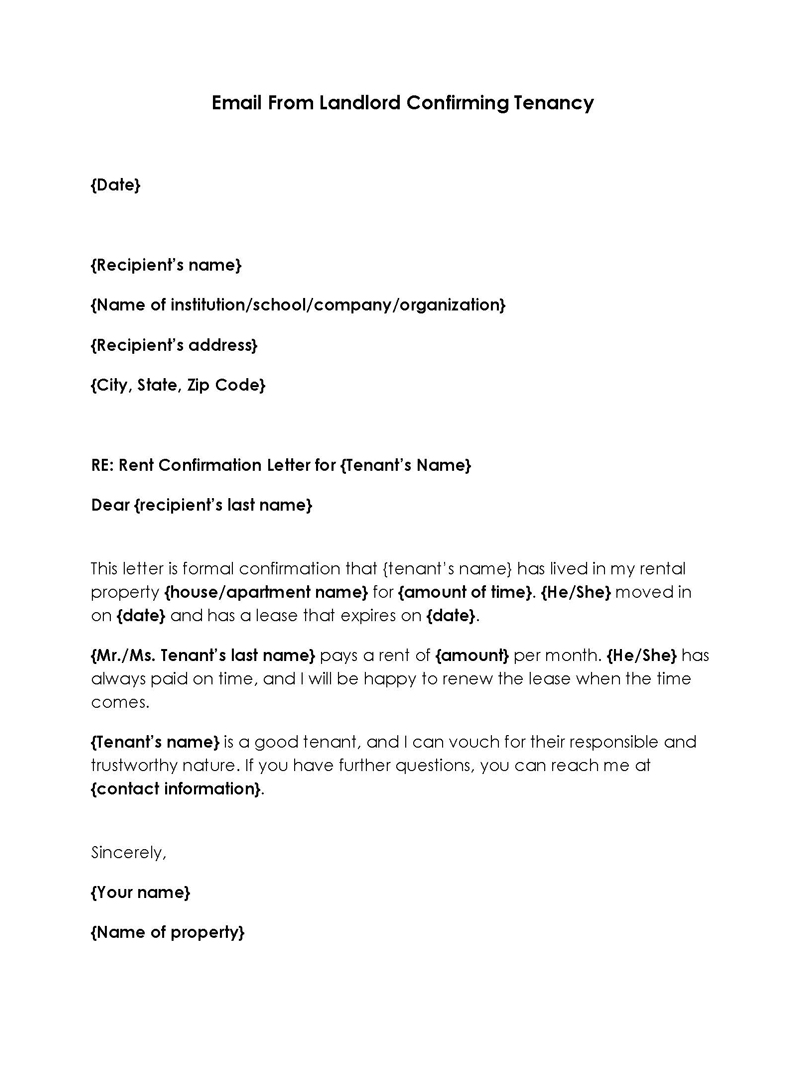
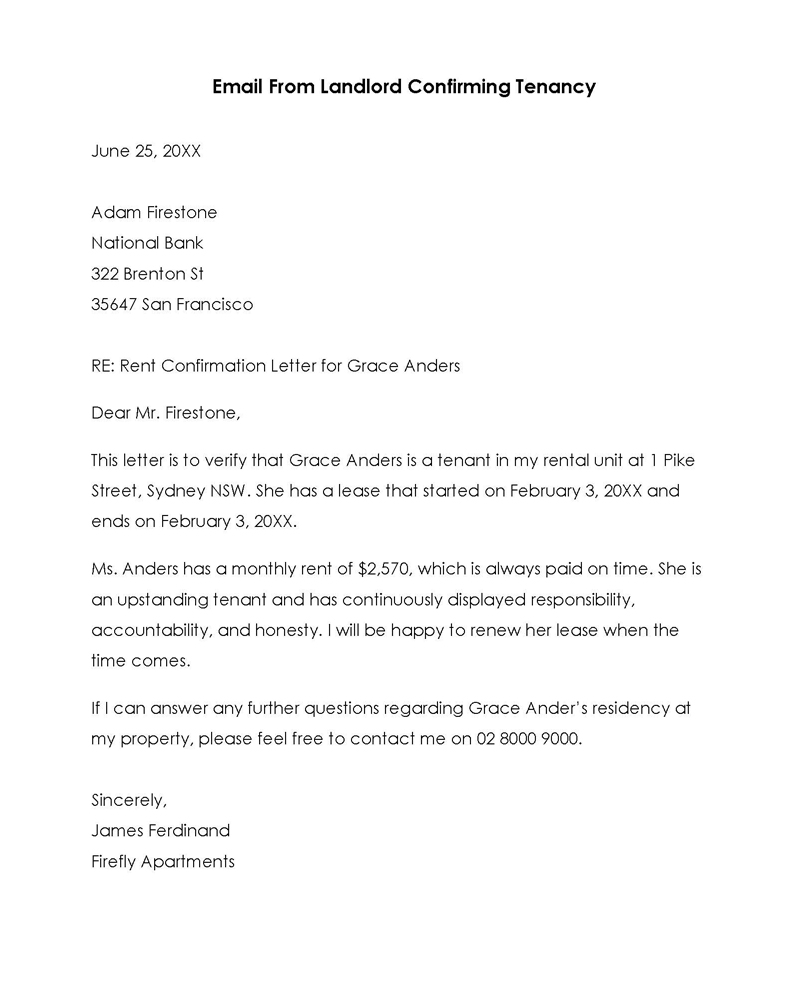
What Should be Included?
These letters should be particular and only include necessary information. That means the first step you can take is to find out what specific information needs to be included, then stick to that script. That means that each tenancy confirmation letter may be slightly different depending on what is required.
In general, you’ll include a simple statement confirming that a tenant lives on your rental property at a specified address. Then, you’ll include the lease details (rental amount, duration, when the tenant moved in, and when they may move out). Finally, you’ll include if anyone else is also on the lease and if anyone else is currently on the property as well.
Proof of Residence v/s Landlord Reference
There is a clear difference between a proof of residence letter and a landlord reference letter. The proof of residence is a factual document that only confirms tenants are residing at your property. Still, it does not state the quality of the tenant’s rental history or anything. On the other hand, a reference letter usually involves a landlord recommending a tenant. Therefore, it is more personal, whereas proof of residence is a factual statement without regard to their history as a renter.
Pre considerations
It is usual for third parties to request information regarding a tenancy. For example, courts, the DMV, schools, and financial institutions will often do so. In this case, it is necessary to get written permission from your tenant to provide this information. By doing so, you’ll be saving yourself from possible legal challenges that may come from data privacy laws. One good option is to use a signed Tenant Release Form to demonstrate their willingness to release the information.
How to Write Such Letters?
Writing it is a much simpler process than you may imagine. Although all of them should have a similar format, to facilitate the writing process, make sure to include all of the following information when drafting the confirmation letter:
Header
The first section, the header, should mainly include identifying information about both the tenant and the landlord.
It should include:
EXAMPLE
- Date: The first piece of information should be the full date of when you are writing the letter.
- Your name, address, and contact information: As a landlord, the next piece of information you should include is your full name, personal address, and some contact information, such as a phone number or email address. Again, this is not the address of the rental property but rather your address.
- Recipient’s name, address, and contact information: The next piece of information is to be included in the same information but for the recipient. So, for example, if you are writing to a specific institution, you can write the name of that institution rather than the name of an individual.
- The subject of the letter: Next, a brief explanation of the purpose should be included. This can be one line, such as “Proof of Residency Letter” or “Letter Confirming Tenancy”.
- Greetings: Finally, a simple greeting should be used to start the letter. For example, you can use “To Whom It May Concern” if you do not know the intended recipient’s name.
Introduction
The following section is the introductory paragraph. An introduction should be a very brief paragraph and comprise four different pieces of information:
- State who you are: You can start by introducing yourself and state who you are. For example, if you are a landlord with one rental property, you may say that. If you own a rental agency, that can also be stated.
- Write the purpose of writing: After introducing yourself, it is appropriate to mention the purpose briefly. This keeps it concise and helps ensure that the intended reader immediately understands what it is for.
- Mention the tenant’s name: In this first paragraph, it’s essential to refer to the tenant by their full name. Rather than giving any nicknames, their full legal name should be mentioned, as they usually need this tenancy confirmation to carry out some formal tasks.
- Specify the length of your professional relationship with the tenant: Finally, the last piece of information to be included in the introductory paragraph is the amount of time you have had the tenant living in your rental unit. Again, this amount of time should be precise, with actual dates being quite helpful.
Body
The following section is to be included in the body paragraph(s). This is the most crucial section and will include all necessary information required for the tenancy confirmation. In addition, it should include the following information:
- Verify the residence of the tenant: The exact address of the rental unit should be mentioned. This address should be specific, including the city, state, and Zip code, to correspond precisely with whatever they need it for.
- Mention the tenant’s necessary information, name, and address: All the tenant’s contact information should also be included so that there is no possible discrepancy. If they no longer live at the address, then you can include their new address here.
- Mention the start and end dates of the lease: The start and end dates of the lease that the tenant has with you should be mentioned. Additionally, if the lease has been renewed, that can be mentioned as well.
EXAMPLE
If they have rented with you for several years and have renewed twice, that can be something worth including.
- Specify the amount of rent: The amount of rent due each month is another crucial point to be included. Additionally, it may be helpful to write when the rent is due (the 1st, 15th, or 30th).
- Write positive points about the tenant: Finally, if you find it necessary, you may include a few positive points about the tenant.
EXAMPLE
“They have always paid rent on time” is a helpful and relevant piece of information.
Conclusion
Finally, the last section is a professional and straightforward conclusion that is comprised of:
- Greetings: You can give a one-line concluding statement that welcomes the recipient to contact you with further questions if they may have them.
- Your signature: And finally, the letter should include a signature. Again, this can be signed either physically or digitally, depending on the requirements of the intended reader.
tip
Make sure to confirm the details of the letter with your tenant. Let them check whether you have provided all the information accurately. This way, you can ensure that you’ll be protected in case there are any legal disputes.
Template
To further help you with the writing process, the following is a template for a letter:
[Landlord’s Name]
[Landlord’s Address]
[City, State, Zip Code]
[Email Address]
[Phone Number]
[Date]
[Recipient’s Name or “To Whom It May Concern”]
[Recipient’s Address (if known)]
[City, State, Zip Code]
Subject: Tenancy Confirmation for [Tenant’s Name]
Dear [Recipient’s Name/To Whom It May Concern],
I am writing this letter in my capacity as the landlord of [Property Address], to confirm the current tenancy of [Tenant’s Name(s)]. This letter is provided at the request of the aforementioned tenant(s), to serve as an official verification of their residence at the specified property.
Tenancy Details:
- Tenant Name(s): [Tenant’s Name(s)]
- Property Address: [Complete Property Address]
- Lease Duration: Commencing on [Lease Start Date] and concluding on [Lease End Date], with the possibility of renewal upon agreement by both parties.
- Rent Amount: The monthly rent agreed upon is $[Rent Amount].
The property in question is a [brief description of the property, e.g., two-bedroom apartment, single-family home, etc.], which is located in a [mention the area type, e.g., residential area, downtown district, etc.]. The tenant(s) have resided at this property since the start of their lease term and have complied with all terms and conditions set forth in their rental agreement.
I confirm that [Tenant’s Name(s)] has been in good standing throughout the tenure of their lease. They have consistently met their rental obligations on time and have maintained the property in good condition, adhering to all the terms specified in the lease agreement.
This letter is intended to verify the tenancy of [Tenant’s Name(s)] for [specify the purpose if known, e.g., loan application, housing assistance, etc.]. Please note that any further details regarding the tenancy or the property may be subject to privacy laws and the consent of the tenant(s).
Should you require any additional information or clarification regarding this tenancy confirmation, please feel free to contact me directly. I can be reached at [Landlord’s Phone Number] or via email at [Landlord’s Email Address].
I trust that this letter will suffice for your purposes. Thank you for your attention to this matter.
Sincerely,
[Landlord’s Name]
[Landlord’s Signature (if sending a hard copy)]
[Landlord’s Title/Position]
[Contact Information]
Sample Letter Tenancy Confirmation
Subject: Proof of Residence for Emily R. Johnson
To Whom It May Concern,
I, John H. Smith, am writing this letter to verify the residence of Ms. Emily R. Johnson at one of the properties I manage. This letter is provided upon her request for the purpose of serving as proof of her current residence.
Residence Details:
- Tenant Name: Emily R. Johnson
- Property Address: 102 Maple Drive, Apartment 5B, Springfield, IL, 62704
- Lease Term: From January 15, 20XX, to January 14, 20XX, with an ongoing month-to-month renewal thereafter.
- Rent Amount: $950 per month
The property is a two-bedroom apartment located on the third floor of a well-maintained apartment complex in Springfield, IL. The complex is situated in a residential area known for its safety and community-oriented environment.
Ms. Johnson has been a tenant at the above address since January 15, 20XX. Throughout her tenancy, she has been a model tenant, adhering to the terms of her lease agreement, maintaining the property in excellent condition, and making timely rent payments. There have been no complaints from neighbors or other tenants, and Ms. Johnson has contributed positively to the community atmosphere of the complex.
This letter is intended to serve as proof of Ms. Emily R. Johnson’s residence at 102 Maple Drive, Apartment 5B, Springfield, IL, 62704, for the period stated. It is provided at her request and may be used for verification purposes where needed, including but not limited to applications for loans, government documents, or any other situation requiring proof of residence.
Should you require any further information or have any questions regarding Ms. Johnson’s tenancy, please do not hesitate to contact me directly at (555) 123-4567 or via email at johnsmith@propertymgmt.com.
I trust that this letter will suffice for your needs. Thank you for your attention to this matter.
Sincerely,
[Signature (if sending a hard copy)]
John H. Smith
Landlord/Property Manager
458 West Pine Street, Springfield, IL, 62704
Phone: (555) 123-4567
Email: johnsmith@propertymgmt.com
Key Takeaways
This letter serves as a comprehensive and effective proof of residence for Ms. Emily R. Johnson. Its clarity, completeness, and professionalism make it a useful sample for similar situations.
Clear Identification: The letter clearly identifies both the writer, John H. Smith, and the tenant, Emily R. Johnson, along with their respective roles as landlord/property manager and tenant.
Residence Details: It provides specific details about the property, including the address, apartment number, lease term, and rent amount. These details establish the tenant’s residency in a specific location.
Description of Property: The description of the property as a two-bedroom apartment in a well-maintained complex in Springfield, IL, adds credibility to the letter and provides context about the living conditions.
Tenant Behavior: It highlights Ms. Johnson’s positive tenancy, mentioning her adherence to lease terms, maintenance of the property, and timely rent payments. This information reassures the recipient about the tenant’s reliability and responsibility.
Purpose of the Letter: The letter explicitly states its purpose as proof of residence for Ms. Johnson, specifying potential uses such as loan applications or government documents.
Contact Information: Contact information for the landlord/property manager is provided, allowing recipients to verify the information or seek clarification if necessary.
Professional Tone: The tone of the letter is formal and professional throughout, enhancing its credibility and legitimacy.
Overall, these key elements contribute to making the letter effective and useful as a sample for providing proof of residence in similar situations.
Quick Tips for Writing
While the structure of this type of letter is quite simple, there are still several elements to consider before starting the writing process. There are a few essential considerations to keep in mind before even starting the first draft.
Now, to help you write an effective letter, consider following these tips:
Verify the request
The first thing to do is to confirm the validity of the request. If it comes from the tenant, there is no issue, but if it comes from a third party, you should confirm they are a valid agency and inform the tenant.
Make sure you have the tenant’s rent records
Ensure you have records of the tenant’s rental history, including their move-in date and amount of rent, as well as any other relevant information on the lease.
Consult with the tenant
It would be best to speak with the tenant beforehand to ensure they know about and consent to the information to guarantee no data privacy infractions.
Include relevant information
Only the relevant information should be included in the letter. It should be short and to the point, while still including a rental confirmation, specific move-in dates and vacancy, address, and amount of rent due.
Include a character reference letter
It may also be necessary to include a tenant reference letter, depending on the purpose of the original letter.
EXAMPLE
A loan agency may request this information.
Use letterhead
A confirmation letter coming from a real estate agent is much more trustworthy and carries more weight. So, if you are representing an agency or company, then use the appropriate letterhead.
Address appropriately
Ensure that it is being addressed to the appropriate recipient. Most of the time, this information can be provided by the tenant.
Avoid general letter
Make sure that it is particular to the circumstances being asked of you. A generic letter could be misused and, since your signature is on it, that may cause you issues down the road.
Frequently Asked Questions
A landlord reference letter typically includes information about a tenant’s character and level of responsibility, whereas a proof of residence letter is more objective and factual. In addition, the reference letter may include information regarding their behavior and trustworthiness. In contrast, proof of residence only needs to include, at most, whether they pay rent on time.
A tenant should not write a rent confirmation letter; instead, it is the job of the landlord. However, a landlord can use a template to facilitate the process and have the tenant’s permission to include all the information.
The landlord should show the content to a tenant in person before sending it off. Afterward, the landlord should send it via certified mail and keep a copy for their records.











